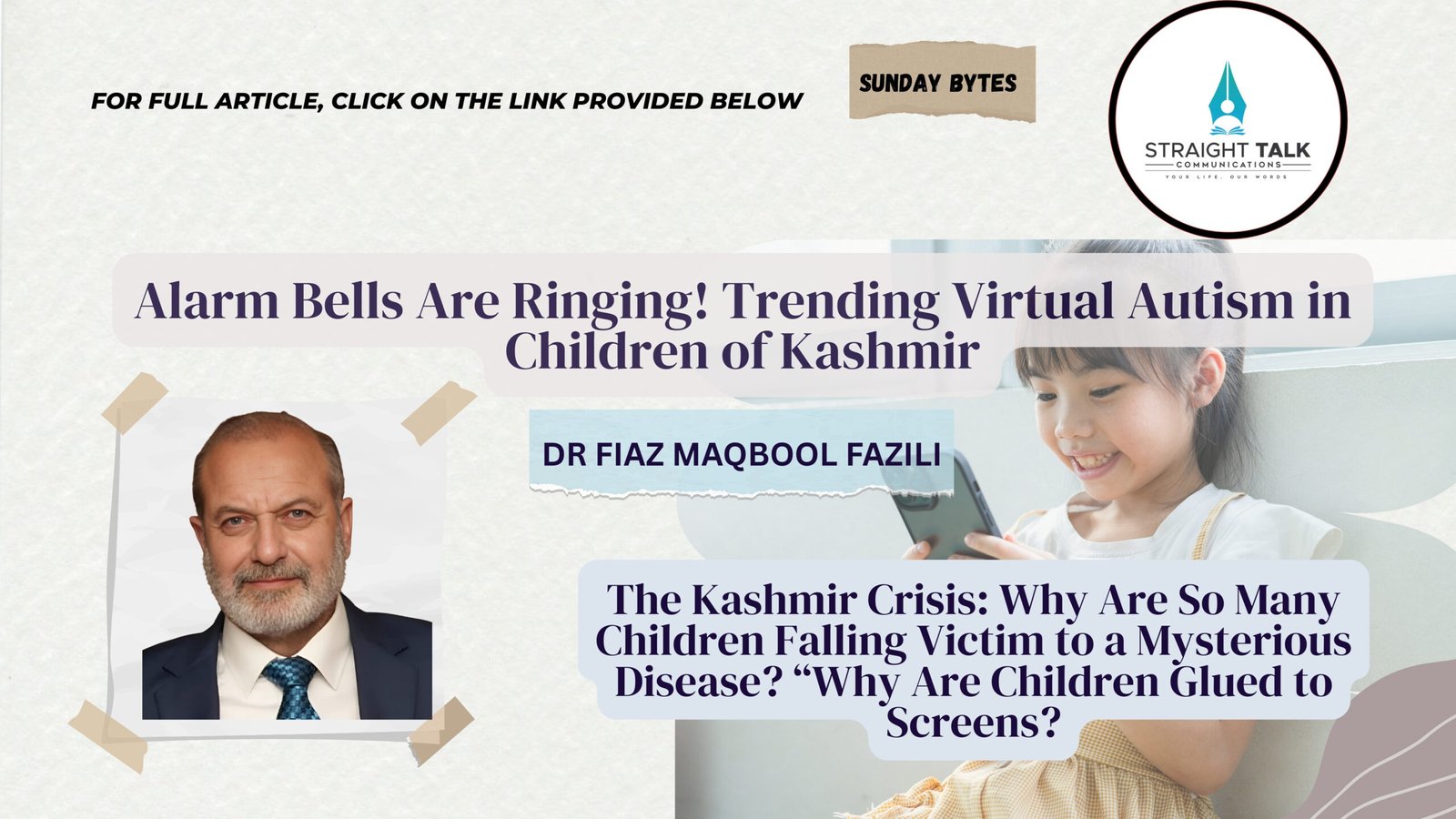Alarm Bells Are Ringing! Trending Virtual Autism in Children of Kashmir

The Kashmir Crisis: Why Are So Many Children Falling Victim to a Mysterious Disease? “Why Are Children Glued to Screens?
DR FIAZ MAQBOOL FAZILI
The Heavy Price We Pay for Technology and Parental Laxity in Upbringing
“A mysterious illness is striking young children in Kashmir, with health experts warning that this alarming trend may only mark the beginning of a deeper crisis.” In the picturesque valleys of Kashmir, where nature’s beauty once captivated the hearts of children, a silent crisis is unfolding. A new phenomenon “Virtual Autism”—is emerging among young children, linked to excessive screen time and parental negligence. As smartphones and tablets replace outdoor play and human interaction, children are exhibiting symptoms akin to autism spectrum disorder (ASD), despite not being clinically autistic. Alarm bells are ringing across the region as psychologists, educators, and healthcare professionals warn of the devastating consequences of unchecked digital exposure. The heavy reliance on technology as a “digital babysitter” and the laxity of parents in monitoring their children’s upbringing are costing Kashmir’s future generation their cognitive, emotional, and social well-being.
Decrease Screen Time – Where Are Parents?
Virtual Autism is a term used to describe autism-like symptoms in children caused by excessive exposure to screens (TV, smartphones, tablets, etc.) during critical developmental years (0-5 years). Unlike clinical autism, which is neurodevelopmental, virtual autism is environmentally induced and often reversible if addressed early. Common symptoms include:Delayed speech and language development, poor social interaction and eye contact, hyperactivity and attention deficits, aggressive behavior and temper tantrums, obsession with digital devices
Research indicates that prolonged screen time disrupts neural connections in a child’s brain, impairing their ability to process real-world stimuli. The World Health Organization (WHO) recommends ZERO screen time for children under 2 and less than one hour per day for those aged 2-5. Yet, in Kashmir, toddlers as young as one are handed smartphones to keep them “occupied.”
The Kashmir Crisis: Why Are Children Glued to Screens?
Several factors contribute to the rise of virtual autism in Kashmir:
1. Parental Laxity and Digital Parenting.Many parents, overwhelmed by work or household responsibilities, resort to screens as an easy distraction for their children. Instead of engaging in meaningful conversations or outdoor activities, children are pacified with YouTube videos or mobile games. The lack of awareness about the dangers of excessive screen time exacerbates the problem.
2. Absence of Alternative Recreational Activities.Due to prolonged conflict and security concerns, outdoor play has diminished in Kashmir. Parks and playgrounds are scarce, and parents fear letting children play outside. Consequently, indoor entertainment is limited to digital devices.
3. Educational Shifts to Online Learning
The COVID-19 pandemic accelerated digital dependency, with schools shifting to online classes. While necessary at the time, many parents continue to allow unrestricted screen access even after schools reopened.4. Influence of Western Media and Cartoons;Children in Kashmir are increasingly consuming fast-paced, overstimulating Western cartoons, which hinder natural brain development. Unlike slow-paced, educational content, these shows rewire young brains to crave constant stimulation, leading to attention disorders.
The Heavy Price Kashmir is Paying; The consequences of unchecked screen addiction are severe: Dr. Alia Gul, a renowned pediatric ophthalmologist at the Eye Care Karan Nagar Research Center in Kashmir, has raised alarming concerns over the rising cases of virtual autism among young children. According to her observations, at least three to four children per week are being brought in with symptoms mimicking autism spectrum disorder (ASD)delayed speech, poor eye contact, social withdrawal, and hyperactivity. However, unlike clinical autism, these cases are linked to excessive screen exposure rather than neurological factors.
Dr.Alia. Alia explains that prolonged exposure to digital devices—smartphones, tablets, and televisions—during critical developmental years (0-5 years) disrupts normal brain growth. The overstimulation from fast-paced visuals and the lack of real-world interactions rewires a child’s cognitive and social development, leading to autism-like behaviors. She warns that if left unchecked, this trend could lead to a lost generation of children struggling with speech delays, attention deficits, and emotional detachment. Her findings align with global research indicating that excessive screen time suppresses neural connections responsible for language and social skills. What makes the situation in Kashmir particularly dire is the lack of parental awareness. Many parents, she notes, mistakenly believe that educational apps and cartoons are harmless or even beneficial. Instead, these digital pacifiers are robbing children of essential developmental milestones. Dr. Alia urges immediate action: strict screen time limits, increased outdoor play, and more parental engagement. She emphasizes that while technology is unavoidable in modern life, its misuse in early childhood comes at a heavy cost—one that Kashmir’s future generation may not afford to pay.
The question remains: Will parents listen before it’s too late?
1. Speech and Language Delays. Pediatricians in Kashmir report a surge in toddlers with delayed speech. Instead of babbling and forming words, these children are engrossed in screens, missing crucial verbal interactions with parents.
2. Social Isolation and Emotional Detachment. Children raised on screens struggle with face-to-face interactions. They lack empathy, fail to interpret emotions, and prefer virtual worlds over real relationships.
3. Rising Behavioral Issues. Teachers observe increased aggression, irritability, and poor concentration in classrooms. Screen-addicted children exhibit withdrawal symptoms when separated from devices, leading to tantrums.
4. Academic Decline. Excessive screen time reduces cognitive abilities, memory retention, and problem-solving skills. Many children perform poorly in school due to shortened attention spans.
Where Are the Parents? The Need for Immediate Action. Parents must take responsibility before it’s too late. Here’s what needs to be done:
1. Enforce strict screen time limits. Under 2 years: No screen time. Age group 2-5 years: Max 1 hour per day (supervised, educational content only). Older children: Balanced usage with parental controls.
2. Encourage physical play and social interaction. Take children to parks, engage in storytelling, and promote group activities. Revive traditional Kashmiri games like Hopscotch (Zang-Tali), Chor spahi and Gul-Danda., whatever is handy.
3. Be present, not just physically but emotionally. Talk to children, read books together, and limit gadget use in front of them. Set an example by reducing personal screen time.
4. Schools and government must intervene. Awareness campaigns on virtual autism in communities. Workshops for parents on healthy digital habits. More child-friendly public spaces to encourage outdoor play.
Kashmir stands at a crossroads—one path leading to a generation of socially disconnected, cognitively impaired children, while the other leads to revival through mindful parenting and reduced screen dependency. Virtual autism is a man-made crisis, and only collective action can reverse it. Parents must wake up before the damage becomes irreversible. The time to act is now—before Kashmir’s children lose their childhood to screens. Together, let’s push these hashtags to the top: #SaveKashmirsFuture #VirtualAutismKashmir #ReduceScreens #MoreRealLifeMoments”







